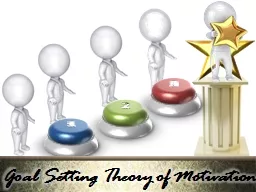

Objective Explain What is Motivation Explain the Theories of Motivation Explain What is Goal Setting Theory of Motivation Describe the Need for Goal Setting in Organizations Explain the Features of Goal Setting Theory ID: 700966
Download Presentation The PPT/PDF document "1 2 3 Goal Setting Theory of Motivat..." is the property of its rightful owner. Permission is granted to download and print the materials on this web site for personal, non-commercial use only, and to display it on your personal computer provided you do not modify the materials and that you retain all copyright notices contained in the materials. By downloading content from our website, you accept the terms of this agreement.
Slide1
1
2
3
Goal Setting Theory of MotivationSlide2
Objective
Explain What is Motivation
Explain the Theories of Motivation
Explain What is Goal Setting Theory of Motivation
Describe the Need for Goal Setting in Organizations
Explain the Features of Goal Setting Theory
Explain the Types of Goals
Explain the Principles of Goal Setting
Describe the Hierarchy of Goals
Explain the Locke-Latham Goal Setting Model
Explain the Steps of Goal Setting
Explain the Relation between Goal Difficulty and Performance
Explain the Role of Feedback in Goal Setting
Explain the Role of Manager’s Influence in Goal Setting Success
Explain the Principles of Motivation for Effective Goal Setting
List the Hurdles to Reaching Your GoalsSlide3
Introduction
George Decker works as a Project Manager at Globus Inc. He is responsible for managing a team of seven team members. George has been facing a lot of problems with his team members. His team has been underperforming for a long time now. All of George’s team members are de-motivated and do not have the enthusiasm or zeal to work.Slide4
Introduction
George was a participant in a workshop on motivation for managers to help them motivate their team members and get the best out of each employee. This workshop was arranged by the Human Resources team of Globus for all the managers at Globus.Slide5
Introduction
At the workshop on motivation, George learned about the ‘Goal Setting Theory of Motivation’. ‘Goal Setting Theory of Motivation’ states that ‘Goal Setting’ is essentially linked to ‘Task Performance’. Slide6
Introduction
After attending the workshop, George learned that one of the best ways to motivate his team members is through ‘goals’.
George decides to apply the ‘Goal Setting Theory’ to motivate his team. Slide7
Introduction
When George’s team members set goals for themselves, they are filled with enthusiasm and feel challenged to achieve the set goal within the timeframe specified by the deadline that they have set for each goal. This lead to an increase in the individual’s as well as the team’s overall performance.Slide8
Introduction
Therefore, you can understand that the ‘Goal Setting Theory of Motivation’ is one of the most important process theories of motivation for motivating employees.
Let us learn about
‘Goal Setting Theory of Motivation’
in detail.Slide9
‘Goal Setting’ is the process of setting, defining and stating goals toward which individuals, teams, departments, and organizations will strive to achieve.
What is meant by Goal Setting?Slide10
What is the Goal Setting Theory of Motivation?
In 1960’s, Edwin Locke put forward the Goal-setting Theory of Motivation.
This theory states that ‘Goal Setting’ is essentially linked to ‘Task Performance’.
It states that specific and challenging goals along with appropriate feedback contribute to higher and better task performance.
In simple words, goals indicate and give direction to an employee about what needs to be done and how much efforts are required to be put in.Slide11
Need for Goal Setting in Organizations
Higher Task Performance efficiency
Reduces absenteeism
Reduces employee turn over
Improves corporate image
Creates good relations
Improves morale
Reduces wastages and breakages
Facilitates initiatives and innovationsSlide12
Features of Goal Setting Theory
The following are some of the important features of goal-setting theory:
The willingness to work towards attainment of goals is one of the main sources of job motivation.
Misunderstanding should be avoided by setting unambiguous, measurable and clear goals accompanied by a deadline for completion for each goal.
Clear, particular and difficult goals are greater motivating factors than easy, general and vague goals.
Specific and clear goals lead to greater output and better performance.
Goals should be realistic and challenging. This gives an individual a feeling of pride and triumph when he attains them and sets him up for attainment of the next goal.Slide13
Assumption 1:
It is assumed that motivation is considered as a process.
Assumption 2:
It is assumed that every individual is ‘Competent’ enough to achieve the goals.
Assumption 3:
It is assumed that goals create motivational forces that motivate employees towards better performance.
The following are the assumptions that were made for proposing the goal setting theory:
Assumption 4:
It is assumed that the set goals and self- related processes are interrelated and interconnected.
Assumptions of Goal Setting Theory Slide14
This is a DEMO Course On –
Goal Setting Theory of Motivation.
Join MSG Premium Membership
and Get Access to around 120 Courses + New courses added every week.
What You Get:
View All Courses Online.
Download
Powerpoint Presentation for Each Course.Do the Knowledge Checks for Each Course.
ManagementStudyGuide.com